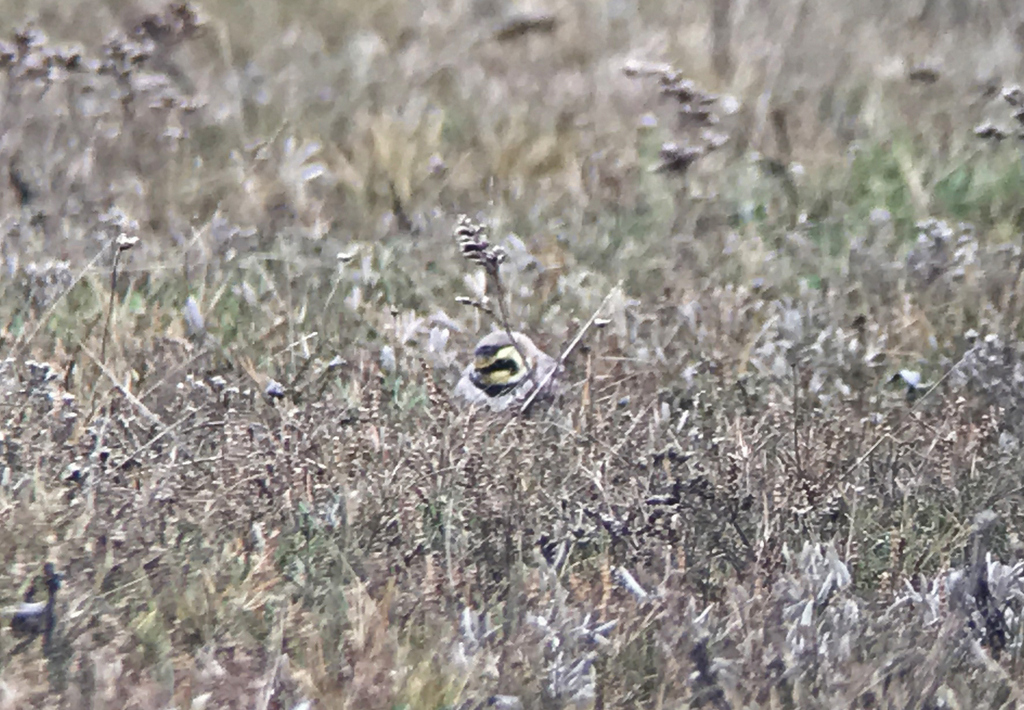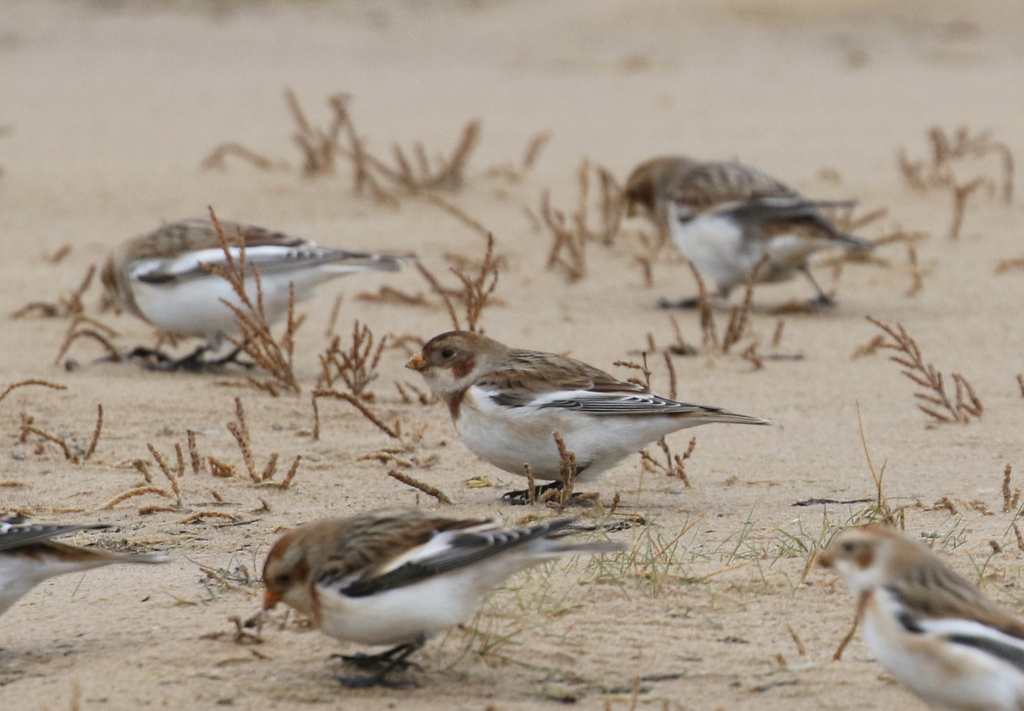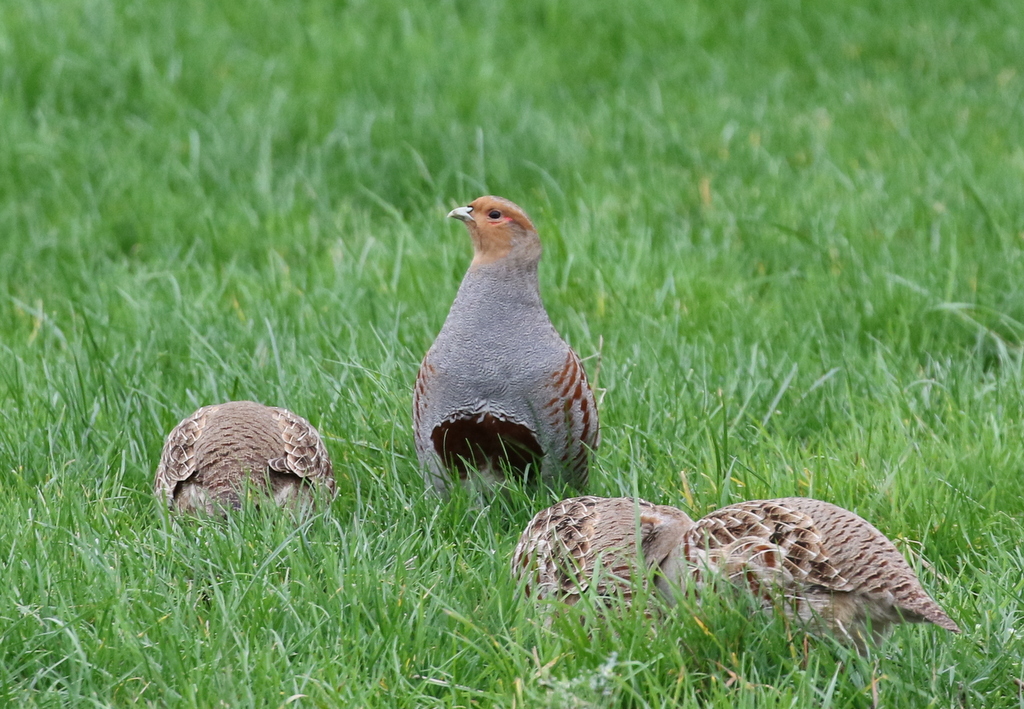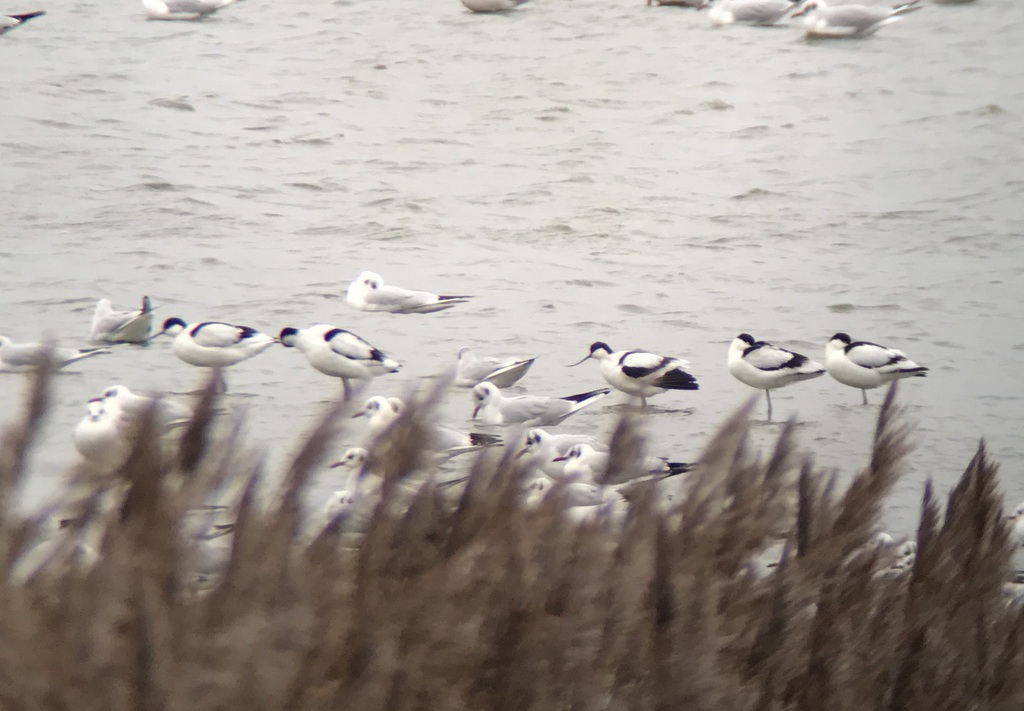Day 2 of a three day Winter Tour today, and we spent the day in North Norfolk. It was a rather windy day today, mostly cloudy and grey, but dry and mild.
Our first destination for the morning was Holkham. As we drove up along Lady Anne’s Drive we could see some Pink-footed Geese in the field by the road, so we stopped for a closer look. We could see their pink legs, even if their feet were hidden in the grass, as well as the pink band around their bills, rather like the orange of the Tundra Bean Geese we had seen yesterday. Thousands more Pink-footed Geese came up off the marshes the other side of the Drive, in several waves with a cacophony of yelping calls, and headed off inland to feed.

There were a couple of Egyptian Geese out on the grazing marshes too, and a large flock of Wigeon. We carried on to the north end where we parked and headed through the pines. A tit flock was working its way across the gap as we walked along the boardwalk and we stopped to watch. As well as the Long-tailed Tits and Blue Tits, a pair of Coal Tits were chasing each other round and round the trees and a Treecreeper climbed up a pine trunk in front of us.
When we got out onto the saltmarsh, we walked east on the path. Three people ahead of us stopped, pointing, and put up their scopes. We had a good idea what they had seen and, sure enough, when we got over to them, they were watching the Shorelarks. They are feeding in the taller vegetation at the moment, not in the cordon, and can be very hard to see. Eventually we saw some movement and managed to get the scope on them.
Every now and then, one of the Shorelarks would stop and put its head up, at which point we could see its distinctive yellow face with black mask. Then it would put its head down again and resume feeding, at which point it would disappear. They were moving all the time. Eventually, one or two came out more into the open and everyone got a good view through the scope.

Watching them creeping around in the vegetation, you could have been forgiven for thinking there were only around five or six Shorelarks there. But when something disturbed them and they all flew, we realised there were actually 26!
We could see another flock of small birds whirl round from time to time over at the far end of the cordon, so we carried on along to there. They were Snow Buntings, and when we arrived they were feeding on the sand along the edge of the water at the very back of the cordon. We had a look at them in the scope, after which they very helpfully flew round again and landed much closer to us, where we had much better views.
We counted twenty-two Snow Buntings today. Looking closely, we could see there was a variety of different coloured birds in the flock, some paler than others, with much more white in the wings as they flew up. Others were much darker, browner. The juveniles are darker and the adults paler, and the males are whiter than the females, but there are also two different races which mix here in the winter, with Snow Buntings from Scandinavia paler than those from Iceland. Lots of scope for variation!

Continuing on out onto the beach, the tide was in and the sea was rather choppy. We couldn’t see a lot out on the water today. A single Common Scoter was rather distant, and a Red-breasted Merganser and a couple of Red-throated Divers flew past. We stopped for a bit and admired the beach, before making our way back. The Snow Buntings were feeding now on the near edge of the cordon and were unconcerned as we walked past a few feet away.
Back at Lady Anne’s Drive, we stopped at The Lookout café to use the facilities. Several flocks of Brent Geese flew in and landed out on the grazing marshes below, and we could see a group of Curlews in field behind. But the highlight was a little covey of Grey Partridges feeding down in the grass just below us. It was great to get such close views of this often rather elusive species.

Looking out across the marshes on the other side of the Drive, we stopped to look at a very pale Common Buzzard perched up in the bushes (which is very often mistaken for a Rough-legged Buzzard!). A Great White Egret appeared on the edge of a reedy ditch – we could see its long, dagger-shaped yellow bill – and a Grey Heron was sheltering from the wind behind some brambles.
We had a quick look at the old pitch-and-putt course along the Beach Road at Wells, but there had been a lot of disturbance earlier from a helicopter over the town and there were very few geese here today. We did find more of the flock of Brent Geese in a winter wheat field just east of Wells, but they had typically found the one spot in the field where we couldn’t see most of them hidden behind a ridge.
Cold and windy is not good weather for owls, but we diverted inland to see if we could find a Little Owl on our way east. Perhaps unsurprisingly, there was no sign of any today. We did find a nice field full of Lapwings, which also included several Golden Plover and four Brown Hares.
Back down on the coast at Cley, we had a drive up along Beach Road. There was another big flock of Brent Geese here, which were slightly more obliging out on the grass. There had been a Pale-bellied Brent reported in with the regular Dark-bellied Brents earlier but there was no sign of it now.
We continued on down to the beach car park, where a flock of Pintail and several groups of Wigeon flew over as we got out of the car. We could see a large flock of Common Scoter offshore, which were constantly flying up in small groups, leapfrogging to the front of the flock and landing again, before diving to feed. Every now and then, we got a flash of a white panel in the wing of some of the otherwise very dark, blackish ducks. These were Velvet Scoter and apparently there had been sixteen of them in total when the whole flock had taken off earlier, though we could only see five or six at a time.
Scanning the rest of the sea, we found several Red-throated Divers, a Great Crested Grebe and a Guillemot all out on the water. There were quite a few people looking at the sea from here, as there was a ‘Bird Race’ taking place at Cley today. Apparently there had been a Glaucous Gull on the sea earlier, which we had hoped to catch up with, but we were told it had flown off west some time before we arrived.
We stopped for lunch in the beach shelter, out of the wind, and afterwards we headed round to the Cley Visitor Centre. We didn’t want to go out onto the reserve today, but we had a quick look out at Pat’s Pool from the terrace. Most of the Avocets leave Norfolk for the winter, but seventeen are currently hanging on here and we could see them feeding out in the water. There were also several Black-tailed Godwits out here and the usual selection of ducks, including a pair of Gadwall, and lots of Black-headed and a few Great Black-backed Gulls.

On the board at the Visitor Centre, there had been a Glaucous Gull feeding on a dead seal pup at Salthouse earlier, as well as several sightings around Cley, although it was difficult to tell whether one or two birds were involved. We had a quick look at the beach at Salthouse just in case, but as we got to the top of the shingle we could see only a young Great Black-backed Gull feeding on the seal carcass and no sign of the Glaucous Gull. Perhaps it was the one we had missed past Cley earlier.
We continued east along the coast to Sheringham. Down on the prom, we quickly located one of the Purple Sandpipers, feeding on the rocky sea defences below. We had a great view of it as it fed on the algae growing on the rocks.

The Purple Sandpiper was on its own today, so we walked back to the ‘tank’, where several Turnstones were feeding on the rocks and more were bathing in a pool below the freshwater outflow on the beach. There were lots of gulls gathering offshore now, mostly Black-headed and Common Gulls. The tide hadn’t gone out far yet and there were just a couple of groups on the beach. There were a few more Herring Gulls here, but nothing different in with them.
The plan was to spend the last part of the day looking for owls, so we headed back to the car and made our way inland. When we arrived, there was no sign of the Barn Owl out hunting yet. We walked down along the footpath, but it was still all quiet around the owl box too. The Barn Owl was late tonight – possibly put off by the wind.
We walked on a little further and scanned the meadows in case one of the other owls was out here, but there was no sign of anything here either. Then when we turned round, the Barn Owl had appeared on the front of the box. It still looked very sleepy, and perched on the platform hunched up with its eyes closed. It was in no hurry to head out hunting tonight.

A Tawny Owl hooted from the wood at the top of the hill and we were just thinking we would have to leave and head off into the trees. Finally the Barn Owl took off, flying back to the sheltered corner of the meadow out of the wind, where it landed on a post. We walked back and watched it flying round hunting – great to watch. When it flew across the path and up the hill, it caught the wind, and we watched it getting buffeted as it turned and tried to come back down. It landed on a post again, then disappeared into the trees, presumably to try to find somewhere more sheltered.

We walked into the trees. It was very windy here and the ivy-covered tree where the Tawny Owl likes to roost was swaying from side to side. As we stood and waited, waves of Pink-footed Geese flew over the trees calling, heading up to the coast to roost. We could see them silhouetted against the last of the light.
The Tawny Owl didn’t hoot before it emerged tonight, as it normally does. Instead, we heard a quiet bubbling call, then it dropped out of the thickest ivy, but landed out of view in the ivy again the same tree. We waited for a few minutes then silently it took off and flew away through the trees. We watched it as it headed off towards an area where it normally likes to perch and hoot for a while. We walked further, along the path, but there was no hooting at all from it this evening, and the trees were all quiet tonight. Perhaps it was just too windy now.
It was getting rather dark in the trees now so we decided to call it a night. As we walked along the path through the edge of the wood, the Barn Owl appeared ahead of us in the gloom, flying down the path. Presumably it was trying its luck in the shelter of the trees.
















